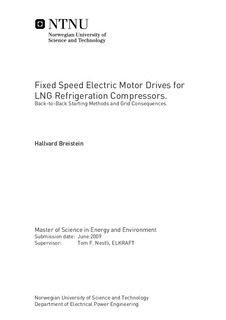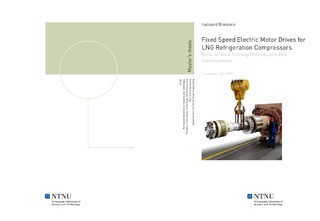| dc.contributor.advisor | Nestli, Tom F. | nb_NO |
| dc.contributor.author | Breistein, Hallvard | nb_NO |
| dc.date.accessioned | 2014-12-19T13:51:23Z | |
| dc.date.available | 2014-12-19T13:51:23Z | |
| dc.date.created | 2010-09-04 | nb_NO |
| dc.date.issued | 2009 | nb_NO |
| dc.identifier | 348804 | nb_NO |
| dc.identifier | ntnudaim:4651 | nb_NO |
| dc.identifier.uri | http://hdl.handle.net/11250/256627 | |
| dc.description.abstract | Experimental studies as well as simulations have been performed on the Back-to-Back starting schemes low frequency-, partial frequency-, and soft -start-up. A Back-to-Back configuration of two synchronous machines has been established in the laboratory, upon which parameter estimation and start-up experiments have been performed. Extensive parameter estimation was conducted in order to replicate the laboratory machines in the simulation model as accurately as possible. This was done in order to verify the validity of the simulation model. Studies into the effects of inductance interconnecting the machines were made in the laboratory and in the simulation model. Effects of resistance and inertia were studied in the simulation model. It is concluded that the simulation model appears to be as reliable as is its input parameters. Discrepancies were found in line voltages, due to faulty implementation of field current replication. Full scale simulations using Motorformer parameters were performed in the simulation model, featuring low frequency- and soft -staring. The effects of an interconnecting cable were studied. It is concluded that low frequency starting appears to be most reliable and least violent starting method. However, it might be limited by the availability of a turbine. This is not the case for soft starting, which has a lower starting capability and is more violent to the motor damper- and field windings. Low frequency startig is the recommended starting method of the ones studied. Dynamic short circuit simulations were done on a fixed speed LNG-facility. The fixed speed alternative appears to be more stable when responding to a short circuit. This is because the motors contribute to upholding the voltage during a fault by delivering reactive power to the short circuit, and because the motors do not loose all torque as is the case for LCI drives when the voltage dip exceeds 20$%$. Further work is needed in up-scaling the experiments. A sophisticated simulation model should be established and its validity tested on the up-scaled experiments. Preliminary custom design of machines should be initiated depending on what starting scheme is chosen. Custom machine parameters should then be used in full scale simulation using the more sophisticated model. | nb_NO |
| dc.language | eng | nb_NO |
| dc.publisher | Institutt for elkraftteknikk | nb_NO |
| dc.subject | ntnudaim | no_NO |
| dc.subject | SIE5 energi og miljø | no_NO |
| dc.subject | Energibruk og energiplanlegging | no_NO |
| dc.title | Fixed Speed Electric Motor Drives for LNG Refrigeration Compressors.: Back-to-Back Starting Methods and Grid Consequences. | nb_NO |
| dc.type | Master thesis | nb_NO |
| dc.source.pagenumber | 81 | nb_NO |
| dc.contributor.department | Norges teknisk-naturvitenskapelige universitet, Fakultet for informasjonsteknologi, matematikk og elektroteknikk, Institutt for elkraftteknikk | nb_NO |

